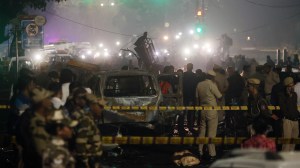Theatre on wheels trains commuters’ minds
The heart of Mumbai is said to beat within the rhythm of the suburban train. When you go to choose a girl to be your bahu don't look at ...

The heart of Mumbai is said to beat within the rhythm of the suburban train. “When you go to choose a girl to be your bahu don’t look at her janam patra,” says a costumed man breaking the rocking monotony of travel. Sundry heads look up and in from windows as he continues, “ask instead for a medical record showing that she does not have AIDS”. The train, this Sunday, has metamorphosised into a theatre and on its stage stands a troupe of actors led by Rajan Verma, director, Centre for Cultural Relations.
Six years old on August 15, Verma’s brainchild – Train Theatre – is aimed at making commuters aware of living issues like AIDS, unity, Kargil, the simplification of Hindi and elections. For Independence Day this year, Verma will bring a play based on the freedom movements in India on to the trains with him and is on the lookout for interested hands to mould his play into shape.
“Local trains are the quintessence of one’s existence in Mumbai. People who undertake long journeys are usually clueless about how to make good use of their time and anything seems worthy of their attention. This provides an ideal platform to communicate information on issues that require public awareness. We stage our plays every Sunday between 1.30 pm-2 pm, selecting a non peak hour so that our audience can be active participants. Originally, the group teemed with a 100 participants but now the floating number fluctuates between 25 and 30. “I am looking for interested people for our Independence Day production,” he adds.
The seed of Verma’s idea is wrapped in the 1993 serial bomb blasts and commmunal riots which severely strained one’s belief in human bonding. “It was the hope of bringing people together as one single unit which embedded the germ of train theatre,” he explains.
Commuters who enjoy the performances can never hope to imagine the logistics of the operation. Hours of planning and practice are the only tools that can cull a smooth performance. Beginning usually at Churchgate station, the artistes form several groups and begin their mini-plays in different compartments. The challenge is to convey a message between stations.
But can a serious perspectives on issues be conveyed in the time it takes to zip between stations? “If a 10 second television commercial can convince a person to buy one detergent over the other, why can’t a 3 minute act leave you with an impression worth pondering over,”, Bhau Saheb Patil, a writer for the group, explains.
The interactive nature of the plays makes their theatre on wheels unique, feels artiste Mahendra Nikale. “If we are doing a play on AIDS, for example, spectators will want to know what the acronym stands for and the causes of the disease. The skits are special because we give our audience a chance to clarify their doubts,” he reveals.
Exhiliration is the artistes’ response to the stress that accompanies their performancds. “You are so close to your audience that it feels like you are whispering messages into their ears,” smiles actor Niyaz Khan who has been with the group since its inception. Most memorable for him was recognition that flashed upon him one day at Dadar station. “I was standing on a platform when a co-commuter spat on it. A bystander came up to me and said Some people will never learn.’ He was a stranger but had recognised me from one of my plays and the elation was incomparable,” he recounts.
In spite of being unique and highly interactive, the medium has its own share of problems. The greatest challenges is the struggle to arrange a flow of finance to keep the show on track. “A sponsor would make a world of a difference,” says Rajan, “as this is the only way to meet production costs. It would be nice to pay our artistes a little, otherwise it is pure interest in the medium and audience response that keep the artists going.







- 01
- 02
- 03
- 04
- 05
























